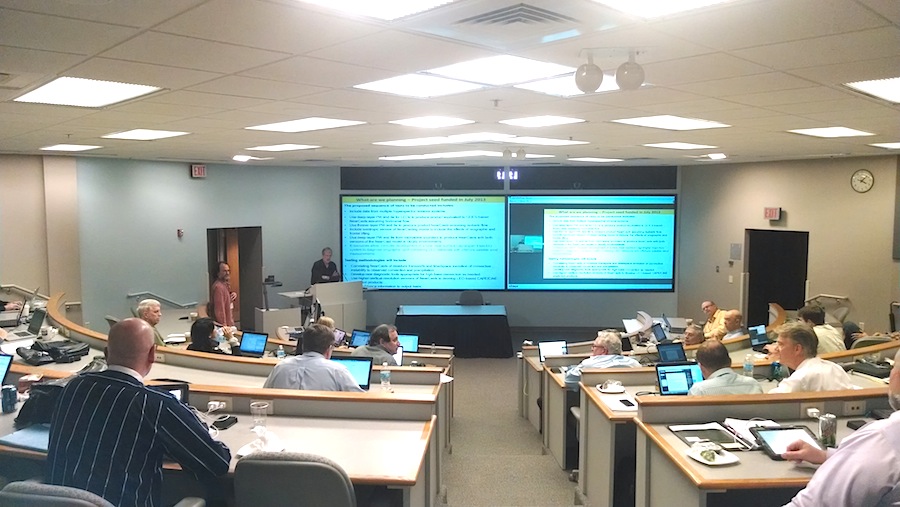
[ Archive ]

 |
ASPB and CIMSS Weekly Report
[ Archive ] |
 |
IN THE PRESS:
ITEMS FOR THE ADMINISTRATOR:
ITEMS FOR THE ASSISTANT ADMINISTRATOR:
ITEMS FOR THE OFFICE DIRECTOR, STAR:
Paper Published on Leo/Geo Atmospheric Motion Vectors: A paper was published in the Journal of Applied Meteorology and Climatology that describes the technique used to generate composites of geostationary and polar orbiting satellite data, the derivation of Atmospheric Motion Vectors (AMVs), and the impact in the National Centers for Environmental Prediction global model. The research was funded by the GOES-R Risk Reduction program. The citation is: Lazzara, M., R. Dworak, D. Santek, B. Hoover, C. Velden, J. Key, 2014: High-Latitude Atmospheric Motion Vectors from Composite Satellite Data. J. Appl. Meteor. Climatol., 53, 534–547. doi: http://dx.doi.org/10.1175/JAMC-D-13-0160.1. (D. Santek, CIMSS, 608-263-7410; M. Lazzara, SSEC/AMRC)
Manuscript on Improving IR Sounder Data Assimilation with Collocated High Resolution Imager Cloud Mask: A manuscript titled "Advanced infrared sounder subpixel cloud detection with imagers and its impact on radiance assimilation in NWP" has been published in Geophysical Research Letters, 41, doi:10.1002/2013GL059067. Co-authors are Pei Wang, Jun Li, Jinlong Li (CIMSS), Timothy J. Schmit (STAR) and Wenguang Bai (CMA). (Jun Li, CIMSS, 608-262-3755, Jun.Li@ssec.wisc.edu)
NOAA Satellite Science Week in Madison: The Cooperative Institute for Meteorological Satellite Studies (CIMSS) and the Advanced Satellite Products Branch (ASPB) hosted the NOAA Satellite Science Week in Madison, WI, March 10-14, 2014. Science Week is a joint meeting and review of the GOES-R Algorithm Working Group, the GOES-R and JPSS Risk Reduction Science activities, and calibration/validation. The goal is to promote interchange between product developers and the user communities, ensuring a path for the transition of research to operations and user readiness. While this was a "virtual" meeting where most participants and presenters were remote, more than 20 members of the various advisory groups came to Madison for face-to-face meetings each day. (J. Key, E/RA2, 608-263-2605, jkey@ssec.wisc.edu)  (Click image to enlarge)
(Click image to enlarge)
Figure caption: Ralph Petersen (CIMSS) presenting at Satellite Science Week.
First Direct Broadcast VIIRS Polar Winds: The first direct broadcast Visible Infrared Imaging Radiometer Suite (VIIRS) polar winds have been generated with data from the University of Alaska-Fairbanks receiving system on 12 March 2014. The winds are produced on-site at the NESDIS Fairbanks Command and Data Acquisition Station (FCDAS, aka Gilmore Creek). (S. Wanzong, CIMSS; J. Key, E/RA2, 608-263-2605, jkey@ssec.wisc.edu; D. Santek, CIMSS)
ITEMS FOR THE DIVISION CHIEF, CoRP:
Presentation Given as part of the Regional OSSE Project: Two presentations were given remotely on February 28 to the Atlantic Oceanographic and Meteorological Laboratory (AOML) and the NOAA’s Advanced Satellite Planning and Technology assessment (ASPT) as part of a Regional Observing System Simulation Experiments (OSSE) hurricane project. These presentations are entitled: Studies on advanced Infrared (IR) sounder for geostationary orbit – Part I: Geostationary IR radiance simulation and evaluation and Part II: Quick OSSE on Sandy case. The presentations are available upon request. (T. Schmit, E/RA2, 608-263-0291, tim.j.schmit@noaa.gov; J. Li, CIMSS, 608-263-1555; J. Li, CIMSS, 608-262-3755)Interdepartmental Hurricane Conference: The Cooperative Institute for Meteorological Satellite Studies (CIMSS) and NOAA/National Climatic Data Center (NCDC) were involved in four presentations at the 68th Interdepartmental Hurricane Conference in College Park, MD. All of these talks highlighted NOAA research being tested in an operational framework. One presentation, entitled "Optimized multi-sensor application in the ARCHER automated TC center-fixing algorithm", presented by Anthony Wimmers (CIMSS) and co-authored by Christopher Velden (CIMSS), described a Joint Hurricane Testbed project to objectively determine storm center locations using multiple satellite platforms. Another talk presented by John Bevin (NOAA/NHC) on "The 2013 satellite proving ground at the National Hurricane Center" featured work by Velden's research group. Finally, a couple of talks about tropical cyclone rapid intensification involved a number of CIMSS efforts, including the presentation "Multi lead-time statistical rapid intensification guidance" presented by John Kaplan and co-authored by CIMSS/NOAA researchers Christopher Rozoff, James Kossin, Christopher Velden, among other co-authors and the talk "Real-time verification of a passive microwave imagery-based statistical model of tropical cyclone rapid intensification", presented by Christopher Rozoff and co-authored by CIMSS/NOAA researchers Christopher Velden, Anthony Wimmers, and James Kossin, and NOAA/AOML's John Kaplan. (C. Rozoff, CIMSS, 608-263-6733, chris.rozoff@ssec.wisc.edu)
VISITORS:
NEXT WEEK:
LOOKING AHEAD:
| Archived Weeklies Page | Submit a report item |